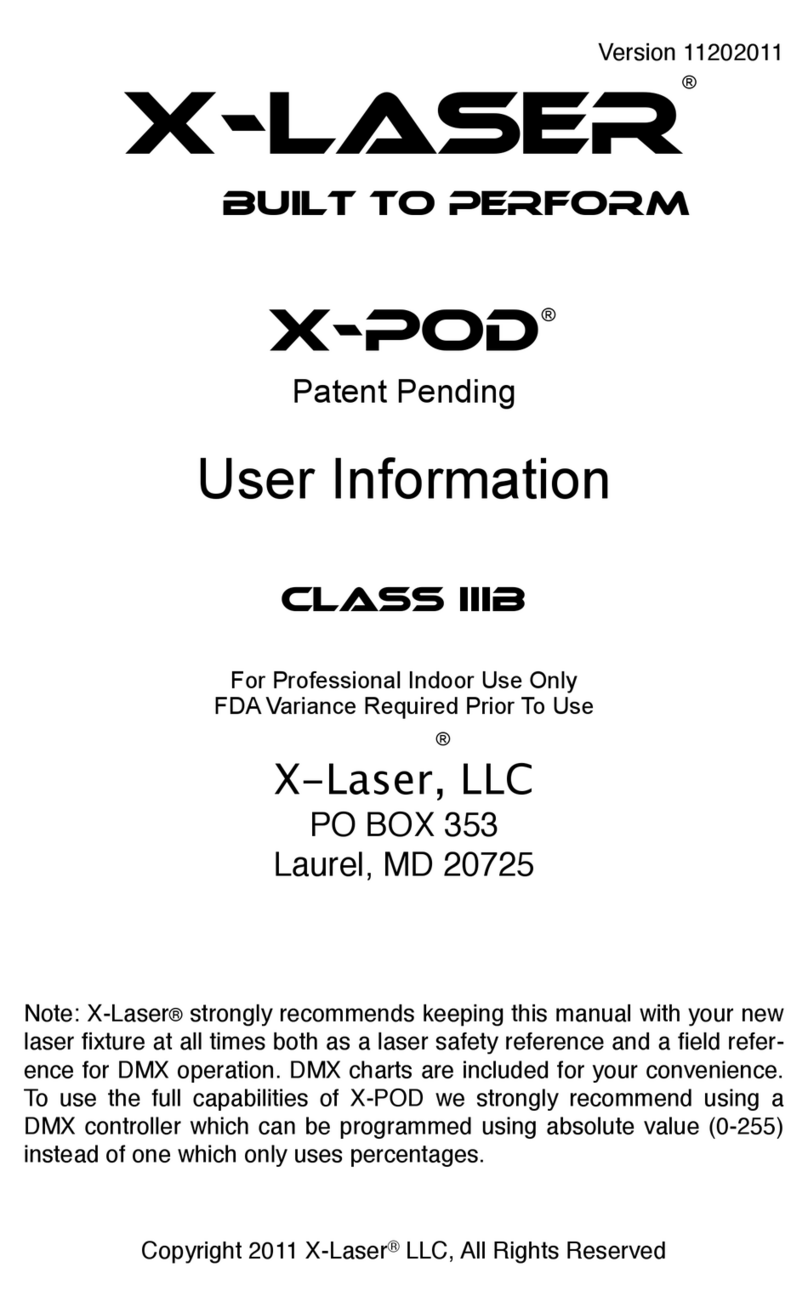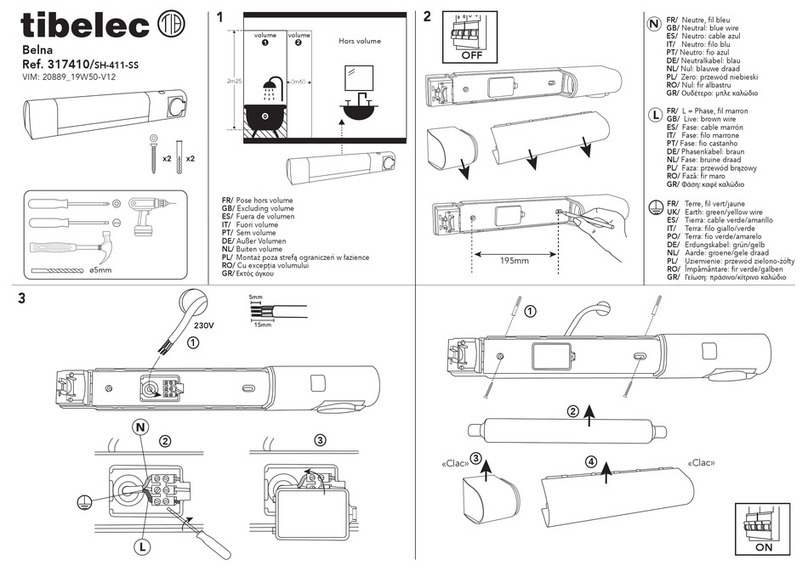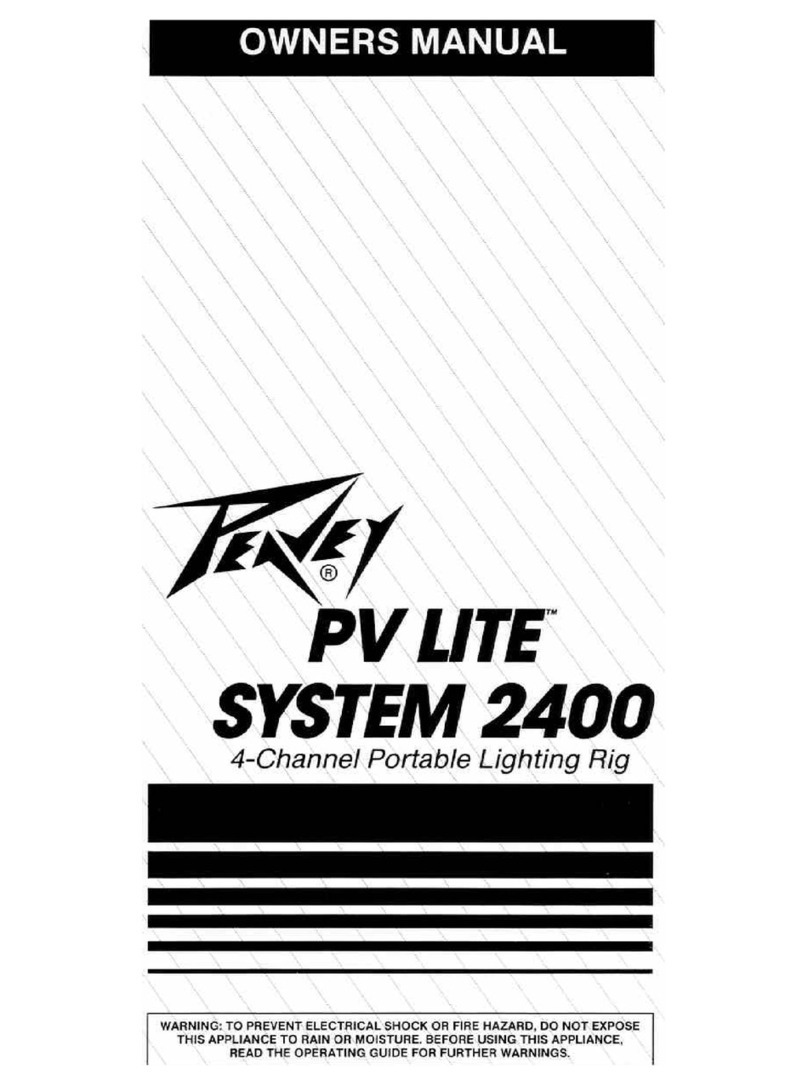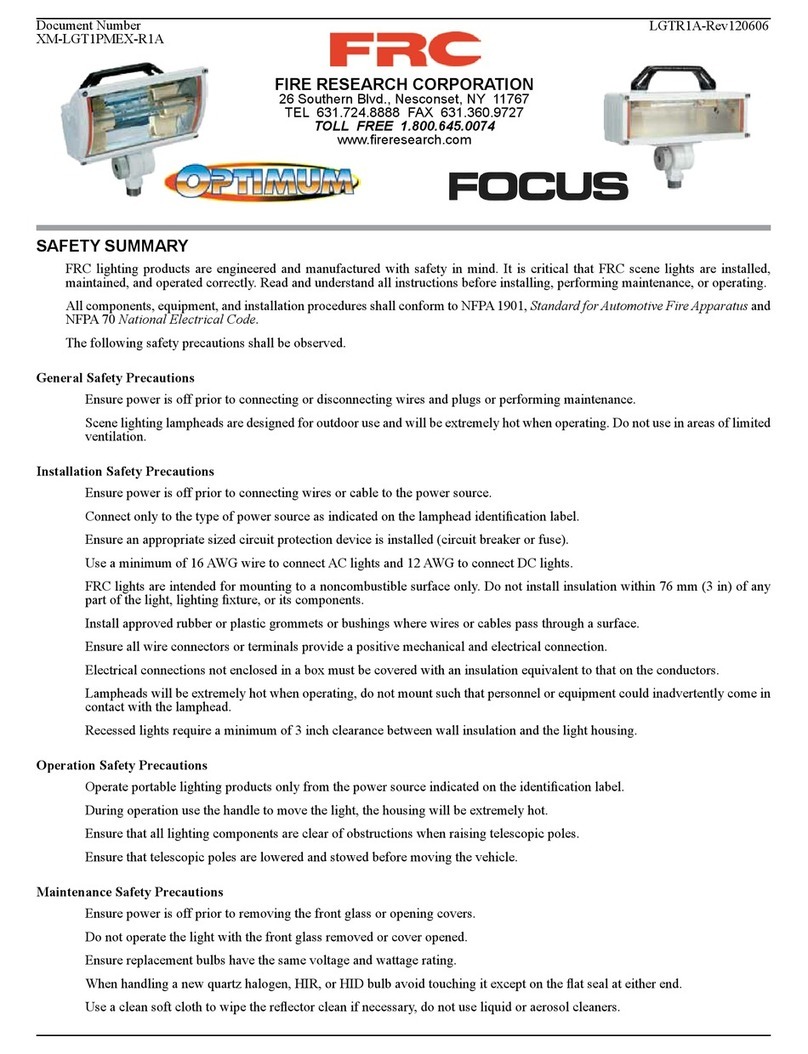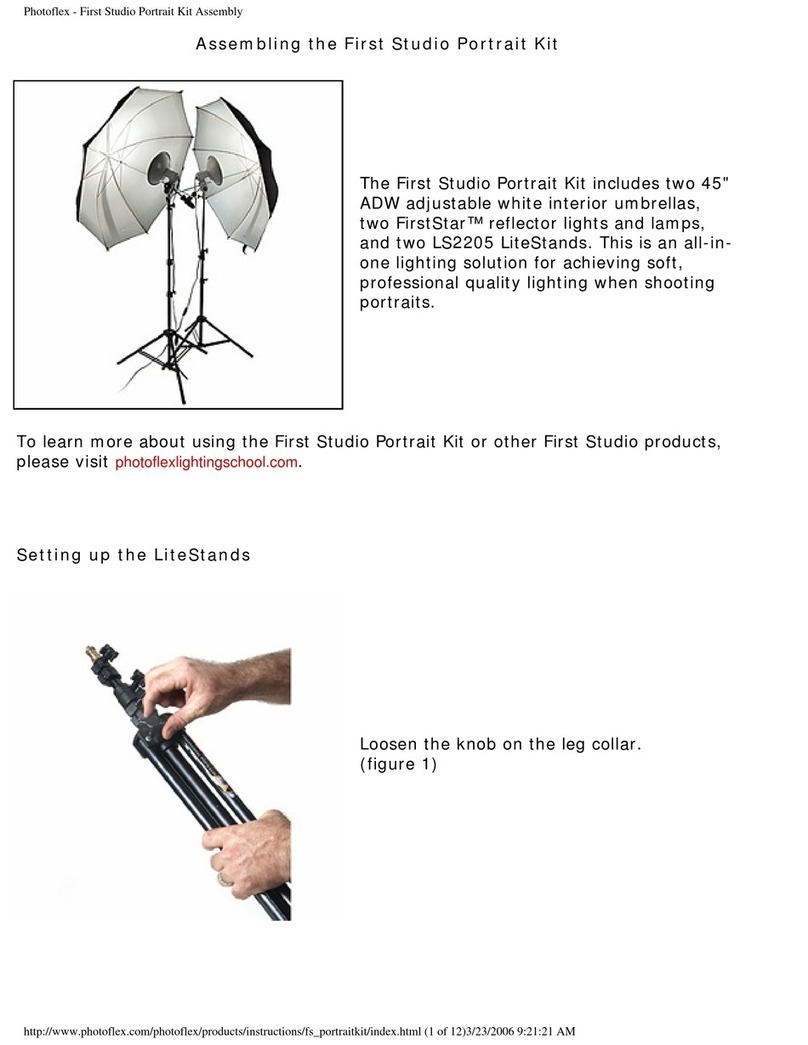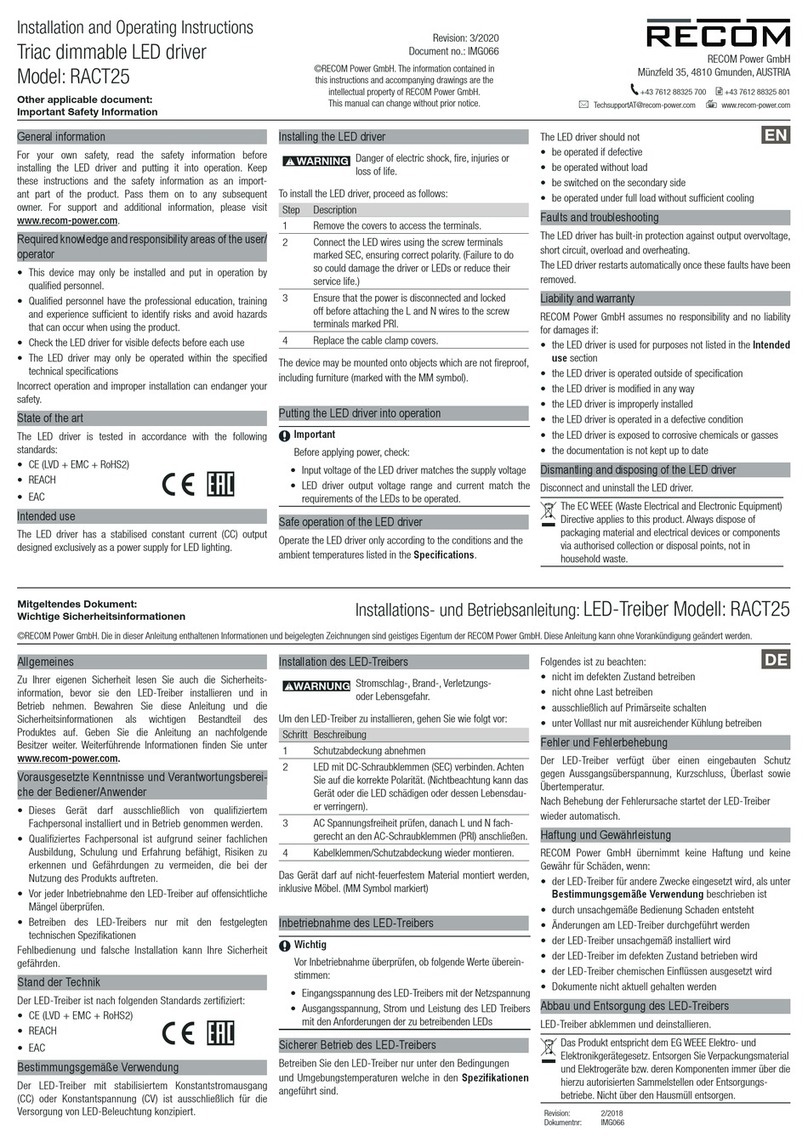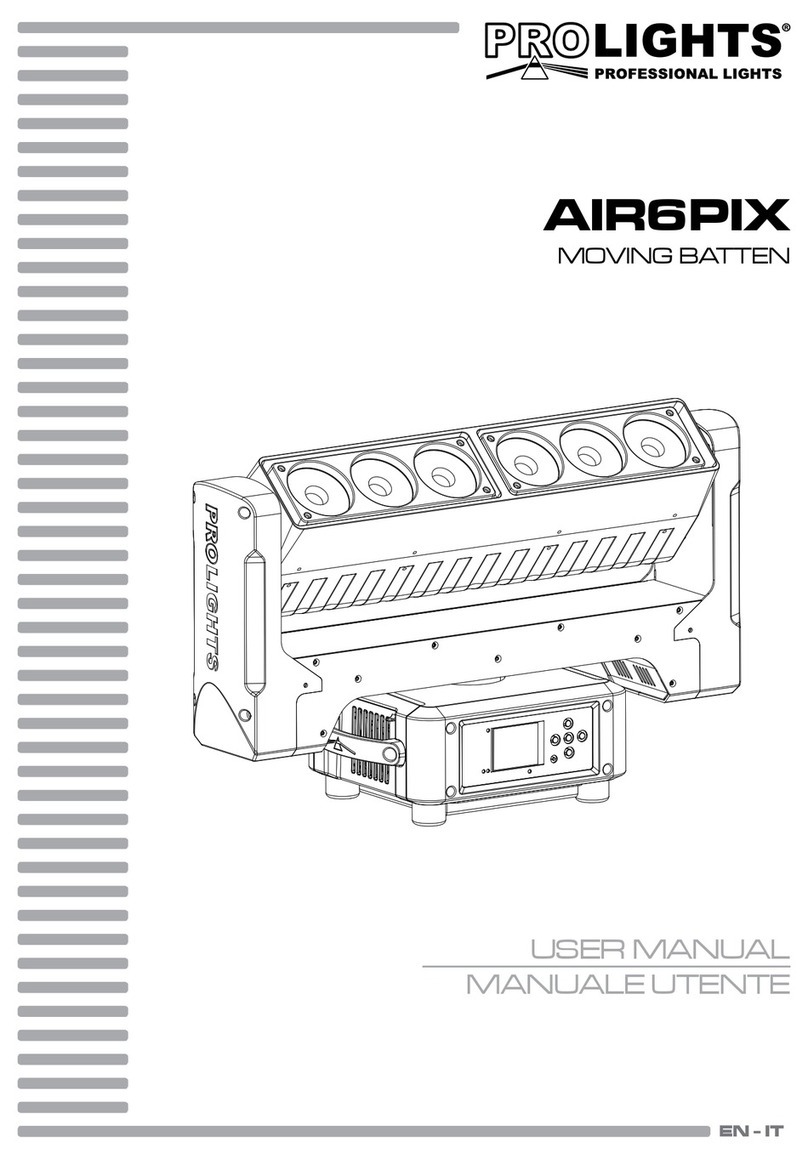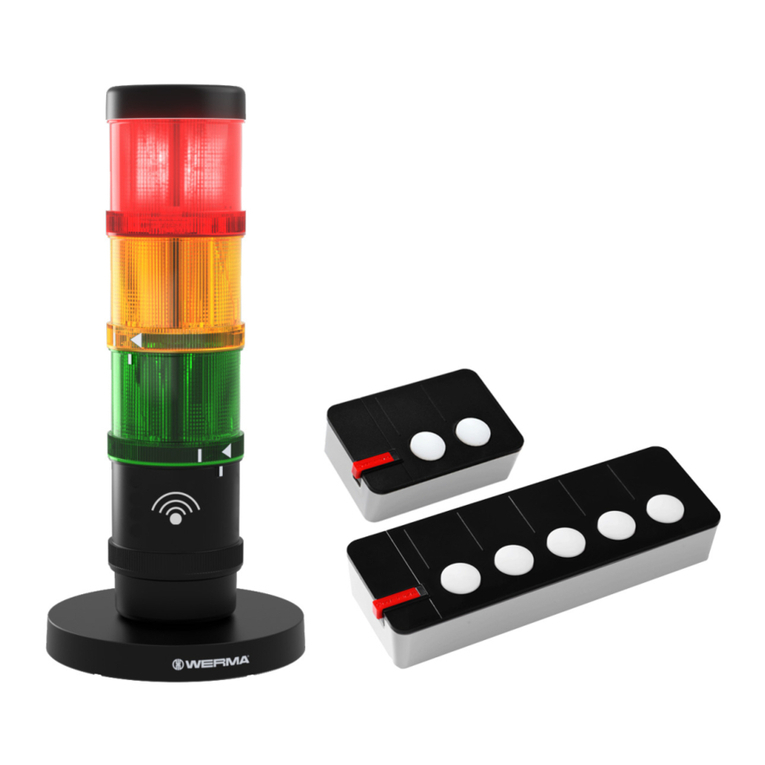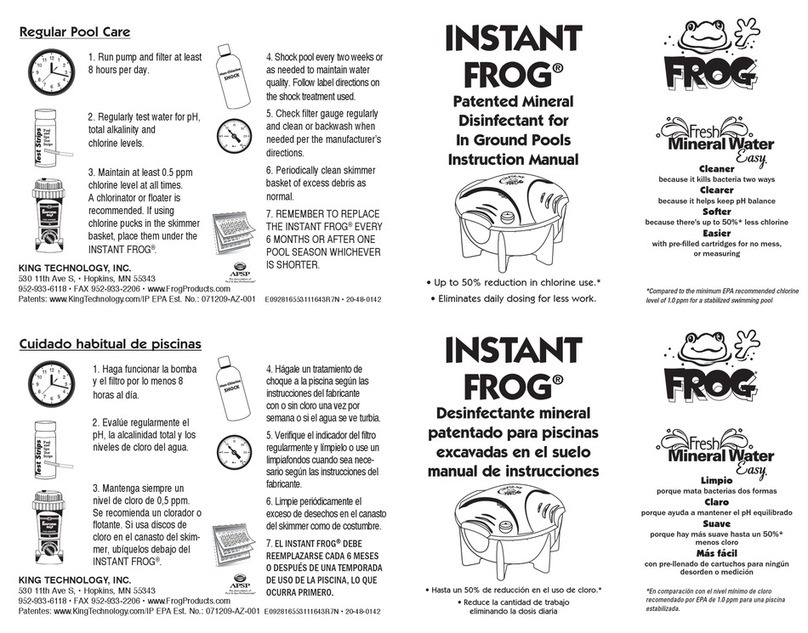ROCKET LAB PSC MOTORIZED Lightband MKII Manual

Copyright PSC 2000781K MkII MLB Operating Procedure Page 2 of 68
TABLE OF CONTENTS
1. REVISION HISTORY...................................................................................................................................3
2. ACRONYMS AND ABBREVIATIONS ........................................................................................................4
3. INTRODUCTION..........................................................................................................................................5
4. WARNINGS ...............................................................................................................................................11
5. ANOMALY REPORTING...........................................................................................................................11
6. HANDLING PRECAUTIONS.....................................................................................................................12
7. LIGHTBAND MECHANICAL ATTACHMENT...........................................................................................15
8. MATING THE LIGHTBAND.......................................................................................................................19
9. STOWING THE LIGHTBAND....................................................................................................................24
10. SETTING-FOR-FLIGHT THE LIGHTBAND ..........................................................................................36
11. DEPLOYING THE LIGHTBAND............................................................................................................45
12. REMOVING THE LIGHTBAND FROM ADJOINING STRUCTURES...................................................57
13. HORIZONTAL INTEGRATION (OPTIONAL)........................................................................................58
14. LIGHTBAND ELECTRICAL SCHEMATICS .........................................................................................60
15. RECOMMENDED SUPPORT EQUIPMENT .........................................................................................61
16. SETUP PICTURES ................................................................................................................................62
17. CAUTION - UNINTENDED ELECTRICAL PATHS...............................................................................63
18. LCT PROCEDURE.................................................................................................................................64
Do not operate the MkII Motorized Lightband (MLB)
before reading this document. Do not operate the MLB
beyond the operating limits.
The MLB does not involve any high-energy liquid, solid
fuels, or any material with inherently physical or chemical
properties.
NOTE: To avoid costly test failures and program delays, all
users shall completely understand this document before
attempting to operate the MkII MLB for any purpose.
Copyright PSC.

Copyright PSC 2000781K MkII MLB Operating Procedure Page 3 of 68
Revision History
Rev
Issued
Created
Reviewed
Change Description
-
02Nov06
RW
RH
Initial document
A
to
J
11May07
to
17Jan19
Varies
Varies
See prior revisions for details.
K
30Oct20
RH
LB
1) Entire document: general formatting and grammatical improvements.
2) Section 1: added DB-9 description
3) Section 2.1: made this a section
4) Table 2-1: updated descriptions, added Mate operation, electrical
column and section references
5) Section 2.3: added this section
Table 2-3: added flatness and circularity equipment
6) Table 2-4: incorporated previous Preparing to Compress equipment,
added PSC equipment
7) Table 2-5: added video camera, increased recommended qty. of
several items for test circuits
8) Section 3: added adjoining structure attachment warning
9) Section 4: added support@ contact email
10) Section 5: added Sep Spring and Retaining Cord handling precautions,
added permitted flange contact
11) Section 6: added flatness and circularity recording, added reminder for
Sep Connector and Switch attachment
12) Section 7: incorporated prior section 12 (Preparing to Compress)
13) Section 7: used to be a part of the Stow section
14) Step 7.1.4: increased measurement locations from 4 to 6
15) Step 7.1.7: this step used to be later in the procedure
16) Sections 8, 9, 10: added several test circuits to account for the various
Lightband switch states. Used to be only one test circuit per operation.
17) Sections 8, 9, 10: added step checking DB-9 cleanliness prior to
Lightband attachment.
18) Sections 8, 9, 10: added step to remove power and measurement
circuit from Lightband after each operation.
19) Step 8.4.4: added rechecking pre-Stow distance
20) Table 8-1: updated allowable values
21) Table 8-2,Table 9-2,Table 10-2: moved to relevant sections, increased
OL resistance to match inspection report
22) Table 9-1: increased allowable time
23) Table 10-1: added note 2 permitting temporary switch reactivation
24) Figure 13-1: updated to include intermediate switch states and
operation directions
25) Section 16: added unintended electrical warnings.
26) Step 17.2.1: now references User Manual for LCT qty.
27) Section 17.5: added instructions to reverse the mate w/ LCTs

Copyright PSC 2000781K MkII MLB Operating Procedure Page 4 of 68
1. Acronyms and Abbreviations
•A (or Amps) –Ampere (SI unit of electric current)
•AR –As required
•Atm –Standard atmospheric pressure (unit of pressure)
•AWG –American wire gauge
•C –Celsius (unit of temperature)
•CG –Center of gravity
•Ch –Channel
•CMM –Coordinate measuring machine
•DB-9 –Common name for a specific electrical connector (used interchangeably with official size DE-9)
•div –Division (scale on oscilloscope)
•Doc –Document (referring to a PSC internal document number)
•DOF –Degrees of freedom
•DMM –Digital multimeter
•ESD –Electrostatic discharge
•FLH –Flathead (type of screw head, conical shape)
•I –Current (measured in Amps)
•IAW –In accordance with
•in –Inch (unit of length)
•lb –Pound force (unit of force)
•LCT –Lightband Compression Tool
•LV –Launch vehicle
•MBA –Motor Bracket Assembly (a subassembly of the MLB)
•Mk II –Mark II, a model designation of the Motorized Lightband
•MLB –Motorized Lightband (used interchangeably with Lightband)
•mtr –Motor
•NC –Normally closed (the switch terminal that permits current flow when the switch is in its free state/not
activated)
•NO –Normally open (the switch terminal that permits current flow when the switch is
depressed/activated)
•NTP –Normal temperature and pressure (20°C and 1 Atm)
•OD –Outer diameter
•Ohm (Ω) –SI unit of resistance
•PS –Power supply or power source
•PSC –Planetary Systems Corporation
•QA –Quality assurance
•R –Resistance (measured in Ohms)
•Rev –Revision
•s –Second (SI unit of time)
•SFF –Set-For-Flight, a Lightband specific operation
•SHC –Socket head cap (type of screw head)
•SI –International System of Units
•SN –Serial number
•SV –Space vehicle
•TVAC –Thermal vacuum (an environmental test)
•typ. –Typically
•V –Volt (SI unit of electric voltage)
•VDC –Voltage direct current (measured in volts)
•W –Watt (SI unit of power)

Copyright PSC 2000781K MkII MLB Operating Procedure Page 5 of 68
2. Introduction
2.1 Scope
This document describes the steps required to adjoin and operate the MKII Motorized Lightband (MLB). Training
and certification by Planetary Systems Corp (PSC), verified via PSC document 3000224 MLB Training Record,
are required to operate any Lightband. The Training Record also specifies the certification’s expiration date.
Ensure this is the latest version of the document by visiting PSC’s website, http://www.planetarysystemscorp.com.
If the version trained on was older than that on the website contact PSC to discuss the changes before
continuing.
Read this entire document before attempting any procedures. This document shall be completed in order. Steps
shall never be skipped unless specifically permitted otherwise.
Contact PSC to clarify any ambiguity or to answer any other questions.
2.2 Lightband Description
The Lightband is comprised of two separable halves. The Lower Ring contains the Hinged Leaves, Retaining
Ring, Motor Bracket Assembly (MBA) and Separation Springs. The Upper Ring, smaller and lighter, contains both
the Leaf engagement grooves and the spring plungers that help the Leaves disengage from the accepting groove.
Typically, the Lower Ring is attached to the launch vehicle (LV) and the Upper Ring is attached to the space
vehicle (SV). The electrical interface to operate the Lightband is a DB-9 socket connector on the outside of the
MBA. See Figure 2-1 to Figure 2-6. For more information on the Lightband see PSC document 2000785 MkII
MLB User Manual.
The Lightband is not ESD-sensitive.
There are four Lightband operations that shall always be performed in order. The Lightband shall always be
attached to adjoining structures per section 6 prior to performing any of these operations.
Table 2-1: Lightband operations
Operation
Description
Requires
electrical
power to the
motors?
Applicable
Section
Mate
Placing the Upper Ring on the Lower Ring and then compressing the
Separation Springs.
No
7
Stow
The electric motors drive components in the Lightband that
mechanically lock together the Lower Ring and Upper Ring.
Yes
8
Set-For-
Flight
The electric motors move internal components of the Motor Bracket
Assembly at low voltage to minimize separation time and standard
deviation. This also verifies motor torque margin prior to Deploying.
Yes
9
Deploy
(separate)
The electric motors drive components that mechanically release the
Lower and Upper Rings. In flight, the Separation Springs will then
elongate and impart relative velocity between the two Rings. On the
ground, the Springs may not elongate due to compressive weights.
Yes
10

Copyright PSC 2000781K MkII MLB Operating Procedure Page 6 of 68
Figure 2-1: MLB15.000-24, Stowed
Figure 2-2: MLB15.000-24, Deployed (also referred to as separated)

Copyright PSC 2000781K MkII MLB Operating Procedure Page 7 of 68
Figure 2-3: Motor Bracket Assembly, internal view
Figure 2-4: Motor Bracket Assembly, external view

Copyright PSC 2000781K MkII MLB Operating Procedure Page 8 of 68
Figure 2-5: Motor Bracket Assembly components, Stowed
Figure 2-6: Motor Bracket Assembly operations

Copyright PSC 2000781K MkII MLB Operating Procedure Page 9 of 68
2.3 Referenced Documents
The following documents are referenced throughout the procedure. Check http://www.planetarysystemscorp.com
to ensure the latest revision. Table 2-2: Referenced documents
Document
Necessary For
2000785 MkII MLB User Manual
Adjoining structure flatness, Lightband circularity, LCT qty., detailed
Lightband description
3000224 MLB Training Record
Verify approval to operate Lightband(s)
1001015 MLB Warranty
-
3000272 Upper Ring Stop Procedure
If using Stow or Deploy Upper Ring Stops to restrain Lightband
2001025 Separation Connector Data Sheet
Attaching Separation Connectors
2002204 Separation Switch Data Sheet
Attaching Separation Switches
2.4 Required Equipment
The items listed below are proven to properly operate the Lightband as presented in this procedure. PSC strongly
recommends using this equipment. All procedure steps listing recommended settings assume the PSC Typically
Used equipment. All equipment substitutions shall be thoroughly vetted prior to use with the Lightband. For
instance, some customers create a custom data acquisition system, thereby negating the need for an
oscilloscope. Further, all electrical paths and Lightband switch states shall be considered. See section 16.
Table 2-3: Mechanical attachment (section 6)
Qty
Item
Make & Model Typically Used by PSC
1
Adjoining structure for Upper Ring
PSC 2000741 Transition Ring
1
Adjoining structure for Lower Ring
PSC 2000741 Transition Ring
AR
0.25 inch SHC fastener (to attach Lower and Upper Rings to
adjoining structure)
NAS1351N4-XX or PSC 4000845
Reduced Head SHC Screw
AR
<0.50 inch OD washer (to attach Lower and Upper Rings to
adjoining structure)
NAS620C416
AR
0.25 inch nut (if applicable, to attach Lower and Upper Rings to
adjoining structure)
NASM21043-4
1
3/16 inch hex key (minimum 1.5 inch shank length) with interface
for torque wrench
-
1
Torque wrench, 150 in∙lb capability
Sturtevant Richmont CCM-150I
1
Small tweezers to aide in fastener handling
-
AR
Isopropanol (to clean adjoining structure and Lightband
interfacing surfaces)
-
AR
Lint Free Wipes (to clean adjoining structure and Lightband
interfacing surfaces)
-
AR
Ability to measure flatness of adjoining structures (granite table
and thickness gages, CMM, laser, etc.)
Starrett 66 Thickness Gage and granite
table
AR
Ability to maintain and measure circularity of Lower and Upper
Rings after attachment (custom flat head screws or gage pins
along with known precise adjoining structure, caliper that spans
MLB, etc.)
PSC 2002753 FLH Alignment Screw
and 2000741 Transition Ring

Copyright PSC 2000781K MkII MLB Operating Procedure Page 10 of 68
Table 2-4: Mating (section 7)
Qty
Item
Make & Model Typically Used by PSC
AR
Ability to compress Lightband (payload, weights, compression
fixture, LCTs). See note 1 below.
-
1
Ability to verify Lightband pre-Stow flange distance. Either
a) Telescoping Gauge and Caliper to measure Lightband
flange separation (1.3 to 2.1 inch range), or
b) Go-no go gauge
Starrett 229C and Mitutoyo 500-175-30
or
PSC 2002486 MLB Go No Go Stow
Gauge
1
Torque wrench capable of indicating 1 in∙lb
Seekonk SL-6 or Capri CP21075S
1
7/64 inch ball hex key to fit on torque wrench (regular hex end
and universal joint may be substituted for ball driver)
-
1) An in-line load cell is highly recommended if using a crane to raise and lower a payload. This allows real-
time monitoring of the Lightband’s net Separation Spring force.
Table 2-5: Operating (sections 8, 9, 10)
Qty
(2)
Item
Make & Model Typically Used by PSC
1
Power source, adjustable, 32 VDC and 6.5 A capability
BK Precision 1687B
12,
26
Patch cord (to create power and measurement and test circuits,
minimum 3.5 A per line, recommend black and red colors)
Pomona, Banana-to-Banana, 18 AWG
1
Oscilloscope, 4 isolated channels
Tektronix TPS2014B
1
Ability to save oscilloscope data and transfer to computer
Compact flash card and reader
2
Current probe for oscilloscope, 0.05 to 4.0 A range
Tektronix A622
1
Adjustable timer relay with trigger, 0.5 to 1.5 s with 0.1 s or finer
increments
Macromatic TD-78122
1
Trigger switch (minimum 7 A & 32 V)
-
2, 6
10 Ω power resistor, ≥100 W, used to simulate Lightband motor
Dale HL-100-06Z-10R00-J-J
1
Digital Multimeter (DMM) with leads
Fluke 77IV
1
DB-9 pin breakout cable to connect to Lightband
custom made
1, 3
DB-9 socket breakout cable for Test Circuits
custom made
1
Digital camera and video camera to record operation
Mobile phone
2) Items with dual numbers are the minimum required quantity followed by the recommended quantity.
Having the recommended quantity will save time.
Table 2-6: Using LCTs (section 17)
Qty
Item
Make & Model Typically Used by PSC
1
Caliper and telescoping gage to measure Lightband flange
separation (1.3 to 2.1 inch range)
Mitutoyo 500-175-30 & Starrett 229C
AR
4000637 Lightband Compression Tool
-
AR
Nylon cable tie, minimum 50 lb breaking strength, 7 inch long
(qty. 1 per LCT pair is required but recommend having extras)
MS3367-1-0 (The ‘0’ specifies the color.
Any final number is acceptable.)
1
Cable tie tool with adjustable force
Ty-Rap ERG 50
1
1/4 inch open end wrench
-
1
Dial torque wrench (not break-over), 12 in∙lb capability
Precision Instruments DS1F15CHNM
1
3/32 inch hex key attachment for torque wrench
-
1
Wire cutter (to cut cable tie)
-
1
Optional: break-over torque wrench with 3/32 inch hex key, 12
in∙lb capability (useful if access to LCTs is limited)

Copyright PSC 2000781K MkII MLB Operating Procedure Page 11 of 68
3. Warnings
Violating any of the below shall void PSC document 1001015 MLB Warranty.
1. All technicians completing this procedure shall be trained directly by PSC and given authority to operate the
Lightband(s) stated in PSC document 3000224 MLB Training Record.
2. The Lightband shall only be operated using this procedure. This procedure shall be filled out for every
operation of the Lightband. Steps shall not be skipped or modified unless they specifically permit otherwise.
3. If a Lightband ever fails to operate correctly, PSC shall be contacted for recommendations and
troubleshooting techniques. Subsequent operations shall not be attempted without first understanding the
cause of the failure. See section 4 Anomaly Reporting for instructions.
4. The Lightband shall always be attached to adjoining structures per this procedure prior to Stowing.
5. All fasteners shall be used when attaching the Lightband to adjoining structures. Fasteners shall not be
omitted from any mounting hole in the Lightband.
6. Never power the Lightband in the Stow direction without the Upper Ring Mated per Section 7. This would
cause damage by repeatedly slamming the MBA drivetrain against a hard stop at high speed and force.
7. The tolerance on the pre-Stowed Lightband distance is not the same as the Stowed tolerance. Ensure
objects, like wiring harnesses, routed between the Lightband flanges do not inhibit proper operation. Also do
not leave stiff objects, like gage blocks, between the flanges during Stow.
8. The Upper Ring shall be physically separated from the Lower Ring after every Deployment. A Stow operation
shall not be attempted without first inspecting the Lightband.
9. Both motors shall always be powered when operating the Lightband.
10. The Lightband shall only be Stowed within the temperature range of 10 to 32 °C (50 to 90 °F).
11. PSC sends power to both motors simultaneously (via a single relay) in all operations. The customer may
power each motor via separate circuits provided the timing is synchronized within 0.005 s. This applies to
power on and power off.
4. Anomaly Reporting
If an anomaly occurs, contact support@planetarysystemscorp.com with all the below requested data. Providing all
data will avoid confusion and expedite PSC’s response.
1. Stop immediately and maintain the existing configuration (if safe).
2. Thoroughly document the Lightband’s state with pictures and notes. Pictures of the MBA, Hinged Leaves, and
Upper Ring internal leaf grooves are often valuable when troubleshooting. Verify the quality and focus of
every picture prior to sending.
3. Provide the three prior operation’s electrical profiles (if applicable to anomaly) as an Excel file. Ensure all data
is properly formatted, titled, graphed and labeled. Sending only the raw oscilloscope .CSV files will
significantly increase PSC’s response time. Ensure all date labels correspond to the actual event date.
4. Provide a copy of this as-run procedure.
5. Provide any relevant operation details including, but not limited to:
a) Adjoining structures. To what is the Lightband bolted?
b) To date, how many Lightband operations have been performed?
c) Reason for operation. Was it an environmental test, avionics verification, integration, etc.? This informs
potential failure modes.
d) Are all components accessible? Are there any access restrictions? Is the Lightband in a clean room?

Copyright PSC 2000781K MkII MLB Operating Procedure Page 12 of 68
5. Handling Precautions
Lower Ring
1. Do not touch the ball screw. Be especially careful when installing fasteners adjacent the Motor Bracket
Assembly. See Figure 5-1.
2. Do not touch the portion of the Hinged Leaves that engage the Upper Ring. Do not wipe off the grease
during cleaning. See Figure 5-2.
3. Do not grab the motors or use them to rotate the Lower Ring.
4. Do not allow the motors to contact anything. This is especially crucial when rotating the Lower Ring. See
Figure 5-3.
5. Do not touch the gear cover on the Motor Bracket Assembly. See Figure 5-4.
6. Do not grab the Separation Springs or use them to rotate the Lower Ring. See Figure 5-5.
7. Do not touch the Leaf Retaining Cord. This is especially applicable when attaching the Lower Ring to
adjoining structures. See Figure 5-6.
Upper Ring
1. Do not touch the Leaf groove. Do not remove grease from the groove when cleaning. See Figure 5-2.
2. Do not touch the spring plungers. Do not allow the spring plungers to contact anything. See Figure 5-7.
3. Do not place the Upper Ring “face down” on a surface if there are Separation Connectors or Separation
Switches installed. Doing so could damage or contaminate Connector pins, Switch plungers or the Upper
Ring flange. See Figure 5-8 .
Figure 5-1: Carefully install fasteners immediately adjacent the MBA
Figure 5-2: Do not touch the Leaf lip or its corresponding groove in the Upper Ring

Copyright PSC 2000781K MkII MLB Operating Procedure Page 13 of 68
Figure 5-3: Do not allow the motors to contact the table or any other objects
Figure 5-4: Do not touch the gear cover
Figure 5-5: Do not touch the Separation Springs
Figure 5-6: Ensure the Leaf Retaining Cord is not contacted

Copyright PSC 2000781K MkII MLB Operating Procedure Page 14 of 68
Figure 5-7: Do not touch spring plungers or allow them to contact anything
Figure 5-8: Do not allow Upper Ring accessories to contact anything
Safely handle the Lightband by grabbing the flanges on the Lower Ring and Upper Rings as shown in Figure 5-9.
Figure 5-9: Uses flanges to handle the Lightband

Copyright PSC 2000781K MkII MLB Operating Procedure Page 15 of 68
6. Lightband Mechanical Attachment
Step
Procedure
Date & Initials
Tech.
QA
6.1.1
Ensure the SN on the Upper Ring corresponds to the SN on the Lower Ring.
Record all Lightband info on the cover page. The assembly number and
revision can be found on both the Upper and Lower Rings, typically adjacent
the Motor Bracket Assembly. PSC document 3000224 MLB Training Record
also lists the MLB sizes and numbers.
6.1.2
The Lightband is designed to accommodate 0.25 inch socket head cap (SHC)
screws and small pattern washers (< 0.50 inch OD). Have ready the required
tools and hardware necessary to attach the Lightband to both upper and lower
adjoining structures. See Table 2-3 and Section 14 for equipment.
-----N/A-----
6.1.3
Verify the flatness of the Lower Ring’s adjoining structure complies with the
most recent version of PSC document 2000785 MkII MLB User Manual. See
note 1 below.
Structure Description: _______________________________________
Required Flatness [in]: _________________
Measured Flatness [in]: _________________
6.1.4
Verify the flatness of the Upper Ring’s adjoining structure complies with the
most recent version of PSC Document 2000785 MkII MLB User Manual. See
note 1 below.
Structure Description: _______________________________________
Required Flatness [in]: _________________
Measured Flatness [in]: _________________
1) Measured Flatness is the final assembled flatness, not the flatness of the individual part. Assembly will
often warp structures so it is imperative to measure flatness after assembly. Measurement does not have to
be real-time. Referencing a prior inspection is acceptable provided it was for the identical configuration.
Step
Procedure
Date & Initials
Tech.
QA
6.1.5
After attachment, the Lower and Upper Rings must meet the circularity
requirement (may be specified as bolt circle tolerance) in PSC document
2000785 MkII MLB User Manual and Step 6.1.13. Plan out the method that will
be used to ensure the requirement is met. Also ensure the circularity of both
adjoining structure bolt circle patterns is known. Forcing the Lightband to align
with non-circular mounting holes will cause an anomaly. Some alignment
method examples are
•Using flat head alignment screws into an adjoining structure with
threaded holes (structure’s bolt circle circularity must be known to meet
requirement)
•Using 3X or more gage pins to maintain circularity during attachment
(structure’s bolt circle circularity must be known to meet requirement and
thru holes must of similar size as Lightband, ~.281 in)
•Using calipers or a CMM to measure diametric distance across Lower
Ring and Upper Ring flanges after attachment.
What method will be used to ensure circularity? _____________________
-----N/A-----

Copyright PSC 2000781K MkII MLB Operating Procedure Page 16 of 68
Step
Procedure
Date & Initials
Tech.
QA
6.1.6
Will Separation Switches or Separation Connectors be attached to the
Lightband? If so, carefully review PSC documents 2001025 Separation
Connector Data Sheet and 2002204 Separation Switch Data Sheet for unique
attachment requirements. Also ensure sufficient tool access will be available as
adjoining structures often overhang the Lightband and restrict access.
-----N/A-----
6.1.7
The mating surfaces of both adjoining structures and the Lightband interface
surfaces shall be visibility clean, to the normal unaided eye, of all particulate
matter and non-particulate film matter. If not, clean with isopropanol soaked lint
free wipes.
6.1.8
Lower Ring attachment to adjoining structure for all Lightbands except the
MLB 15.000-24 (unless using reduced head fasteners).
Place the Lower Ring on the adjoining structure. Insert fasteners and washers
through mounting holes. It is often easier to place the washer on the Lower
Ring prior to inserting the screw. Tighten fasteners until hand tight. See Figure
6-2 & Figure 6-4. Then skip to step 6.1.10.
6.1.9
Lower Ring attachment to adjoining structure for the MLB 15.000-24 only. (If
using reduced head fasteners per section 14 follow step 6.1.8 instead.)
The spacing between Leaves is tight and requires a unique attachment
procedure.
1. Elevate the Lower Ring off the table. This will permit the screws to protrude
below.
2. Place only the washer on the Lower Ring.
3. Insert the screw. If the screw head rubs, push on each adjacent Leaf Pin to
move it out of the way slightly.
4. If the adjoining structure has through holes place the Lower Ring on the
structure allowing all screws to drop in the holes.
5. If the adjoining structure has threaded holes, the screws must be threaded
gradually. Work around the Lightband, turning each screw a few turns at a
time until hand tight. Take care to prevent the screw heads from jamming
up into the Leaf Pins.
See Figure 6-1 to Figure 6-4.
Figure 6-1: Pushing Leaf Pin to side to make room for SHC screw (15.000-24 only).

Copyright PSC 2000781K MkII MLB Operating Procedure Page 17 of 68
Figure 6-2: Inserting a SHC screw between Leaves on Lower Ring.
Figure 6-3: SHC screw and washer inserted between Leaves on elevated Lower Ring.
Figure 6-4: Separated Lightband halves attached to adjoining structures.

Copyright PSC 2000781K MkII MLB Operating Procedure Page 18 of 68
Step
Procedure
Date & Initials
Tech.
QA
6.1.10
Torque all fasteners on the Lower Ring. Minimum allowable torque is 70 in∙lb.
PSC typically torques 100 to 115 in∙lb. Higher torque is allowable for high line-
loading. See note 2.
6.1.11
Attach the Upper Ring to its adjoining structure by inserting fasteners and
washers through the counterbores. Tighten fasteners until hand tight. Do not
contact the Lightband with the wrench. See Figure 6-4.
6.1.12
Torque all fasteners on the Upper Ring. Minimum allowable torque is 70 in∙lb.
PSC typically torques 100 to 115 in∙lb. Higher torque is allowable for high line-
loading. See note 2.
6.1.13
Verify the circularity of both the Lower and Upper Rings complies with PSC
document 2000785 MkII MLB User Manual. Measurement frequency shall be
sufficient to ensure minimum and maximum diameters are determined. See
note 3 and Figure 6-5. Record results below.
Parameter
Lower Ring
Upper Ring
Stated bolt circle diameter, nom [in]
Circularity tolerance, ±tol [in]
Minimum measured value, min [in]
Maximum measured value, max [in]
Difference, max-min [in]
All requirements met?
2) Customer shall always perform a thorough bolted-joint analysis to ensure sufficient margin on material
strength, joint slipping and joint gapping.
3) If measuring a feature other than the bolt circle diameter, e.g. the distance across diametrically opposing
flanges, the difference between the minimum and maximum values shall correspond to the total circularity
tolerance. For example, a circularity tolerance of ±X implies the flange difference, max-min, shall be ≤2X.
Figure 6-5: Circularity example

Copyright PSC 2000781K MkII MLB Operating Procedure Page 19 of 68
7. Mating the Lightband
Step
Procedure
Date & Initials
Tech.
QA
7.1.1
Verify the Upper and Lower Rings are attached to adjoining structures per
Section 6. Also see section 3 warning #4.
7.1.2
Orient the Lightband such that the wiring will reach the DB-9 electrical
connector. Also ensure 1 ft minimum radial clearance around the Lightband for
pre-Stow distance measurements.
-----N/A-----
7.1.3
Inspect the Lightband to verify:
1. It is visually free from damage.
2. All Hinged Leaves are properly latched over the Retaining Ring. See
Figure 7-1 for proper orientation.
3. The Leaf Retaining Cord is seated in the groove of every Hinged Leaf.
7.1.4
Verify the Sliding Tube can move fully radially inward such that it contacts the
Motor Bracket Deploy hard stops per Figure 7-2. If it cannot, proceed to step
7.1.5.
a) Incorrect Leaf position. b) Correct Leaf position.
Figure 7-1: Verifying Leaf positions
a) Incorrect position (Stowed) b) Correct position (Deployed)
Figure 7-2: Verifying pre-Mate Sliding Tube position

Copyright PSC 2000781K MkII MLB Operating Procedure Page 20 of 68
Step
Procedure
Date & Initials
Tech.
QA
7.1.5
This step shall only be performed if required by Step 7.1.4. This is typically only
necessary prior to the first mate (after unpacking the Lightband).
1. Contacting only the top surfaces, push the Sliding Tube radially outward
(towards the motors).
2. Then, while maintaining force on the Sliding Tube, use a 7/64 inch hex key
to rotate the ball screw clockwise as shown in Figure 7-3. The Ball screw
should rotate smoothly with very low running torque. If torque exceeds 1
in∙lb, stop and investigate.
3. Continue rotating the ball screw until there is approximately a 0.1 inch gap
between the Sliding Tube and Motor Bracket as shown in Figure 7-4. Note
this will require approximately 35 full revolutions.
Figure 7-3: Rotating ball screw to allow Sliding Tube travel
Figure 7-4: Gap after rotating ball screw
Table of contents
Popular Lighting Equipment manuals by other brands
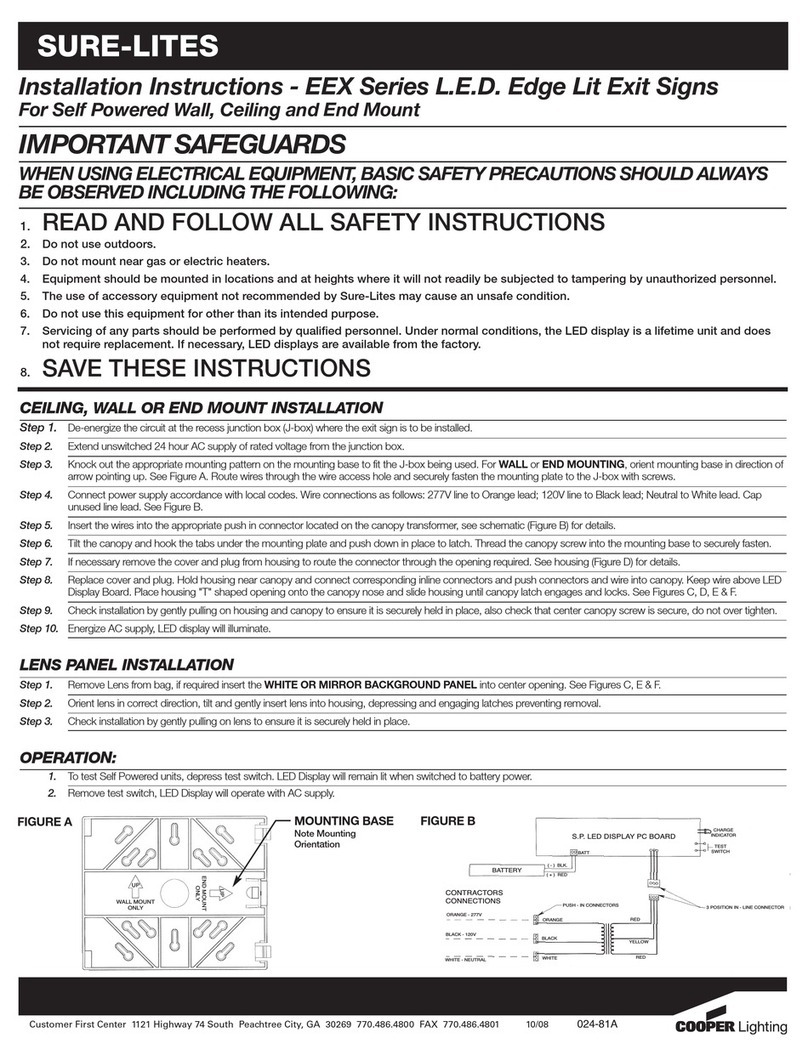
Sure-Lites
Sure-Lites EEX Series installation instructions

Commercial Electric
Commercial Electric 56704111 Use and care guide
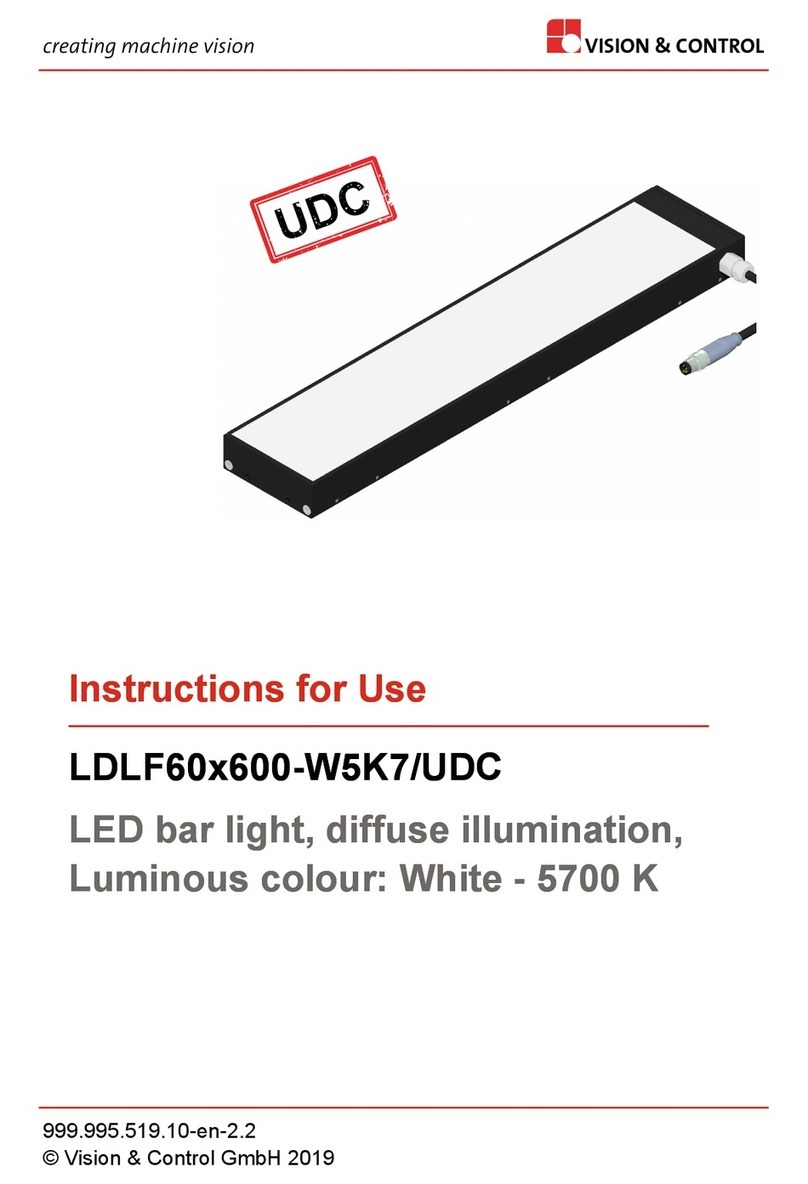
Vision & Control
Vision & Control LDLF60x600-W5K7/UDC Instructions for use
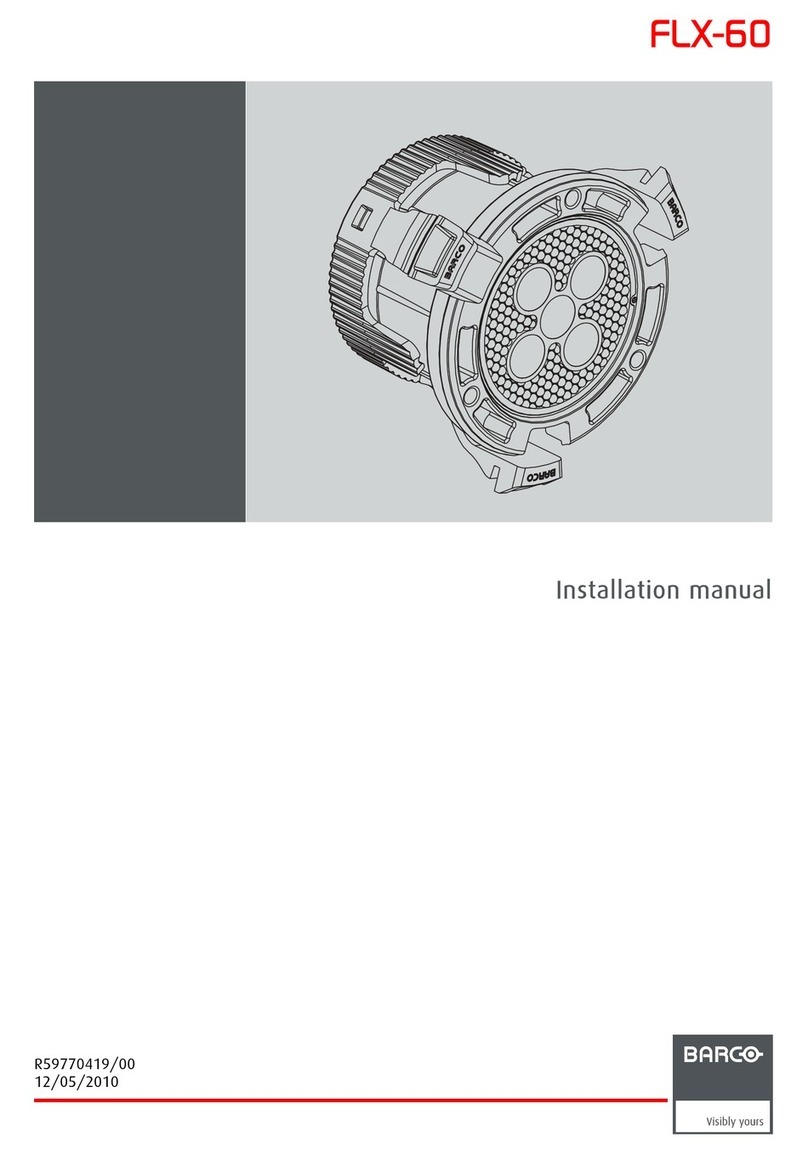
Barco
Barco FLX-60 installation manual
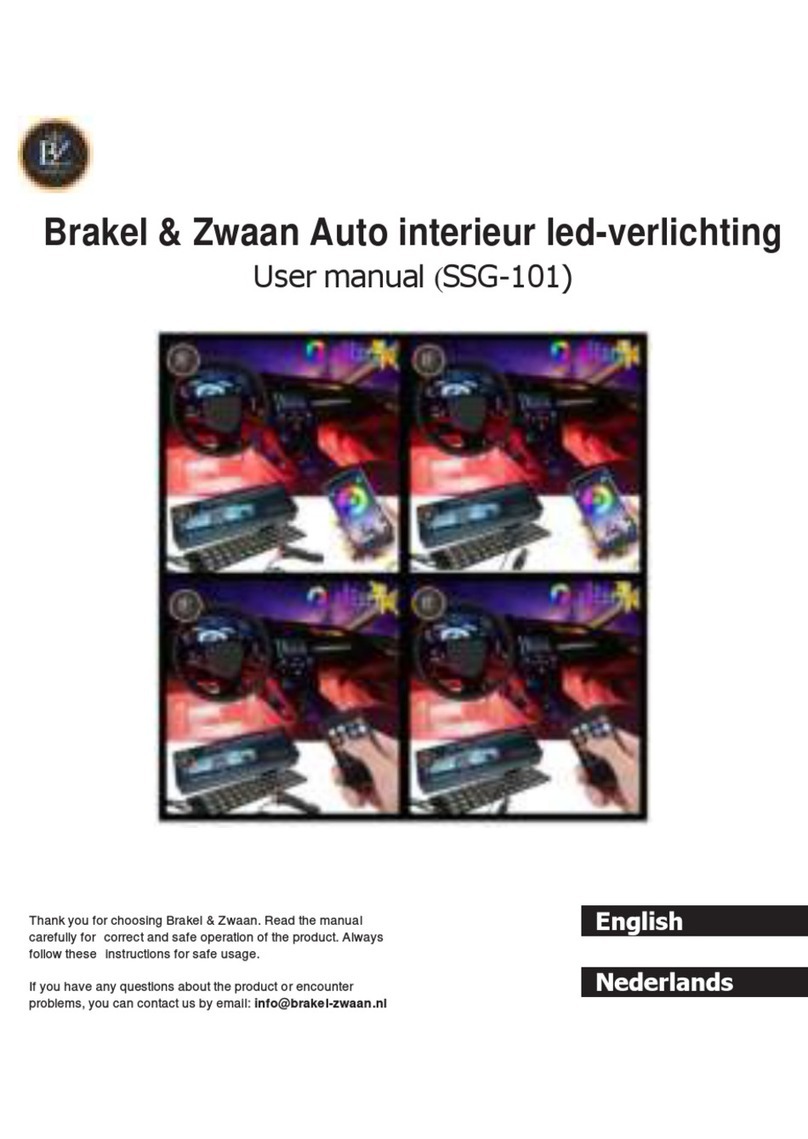
Brakel & Zwaan
Brakel & Zwaan SSG-101 manual
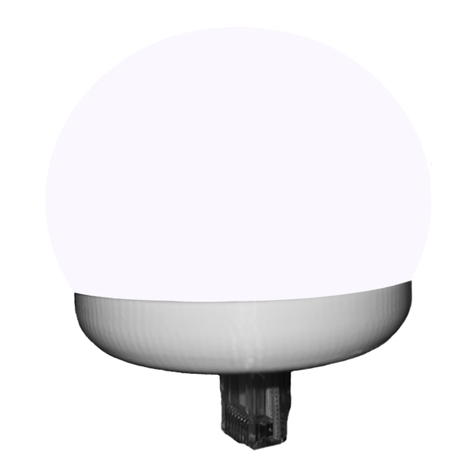
Qeedji
Qeedji SBL10e user manual

